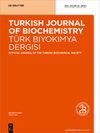Expression of a functional recombinant vascular endothelial growth factor 165 (VEGF 165 ) in Arabidopsis thaliana
IF 0.7
4区 生物学
Q4 BIOCHEMISTRY & MOLECULAR BIOLOGY
Turkish Journal of Biochemistry-turk Biyokimya Dergisi
Pub Date : 2019-06-26
DOI:10.1515/TJB-2017-0368
引用次数: 1
Abstract
Objective: Targeting the protein of interest to a particular tissue to achieve high-level expression is an important strategy to increase expression efficiency. The use of the plant seed oil body as a bioreactor can not only increase the amount of target protein, but also reduce the cost of downstream processing. Methods: VEGF165 was expressed in Arabidopsis thaliana seeds via oilbody fusion technology. The pKO-VEGF165 vector was construted and transformed into A. thaliana seeds. T3 transgenic seeds was detected by SDS-PAGE and western blot methods. The cell activity was tested by MTT methods. Result: The phaseolin promoter was used to drive seedspecific expression of the VEGF165 gene in transgenic A. thaliana. The coding region of VEGF165 was fused to the Arabidopsis oleosin sequence to target the protein to the oil bodies in the seeds of transgenic plants. The T-DNA region of recombinant plasmid pKO-VEGF165 was shifted to A. thaliana seeds via the floral-dip method. Protein was analyzed by electrophoresis and protein hybridization analyses. Finally, MTT assays showed that the oleosinVEGF165 fusion protein played a part in the proliferation of HUVEC cells in vitro. Conclusion: Oleosin-VEGF165 was successfully expressed and it had stimulated HUVEC cell proliferation activity.重组血管内皮生长因子165 (VEGF 165)在拟南芥中的表达
目的:将感兴趣的蛋白靶向特定组织实现高水平表达是提高表达效率的重要策略。利用植物籽油体作为生物反应器,不仅可以增加目标蛋白的量,还可以降低下游加工的成本。方法:采用油体融合技术在拟南芥种子中表达VEGF165。构建pKO-VEGF165载体,并将其转化为拟南芥种子。采用SDS-PAGE和western blot方法检测T3转基因种子。MTT法检测细胞活性。结果:利用phaseolin启动子驱动转基因拟南芥VEGF165基因的种子特异性表达。将VEGF165的编码区与拟南芥油酸蛋白序列融合,将该蛋白靶向转基因植物种子中的油酸体。通过花浸法将重组质粒pKO-VEGF165的T-DNA区转移到拟南芥种子中。蛋白电泳和蛋白杂交分析。最后,MTT实验表明,oleosinVEGF165融合蛋白在体外HUVEC细胞增殖中起作用。结论:Oleosin-VEGF165成功表达,并对HUVEC细胞增殖活性有促进作用。
本文章由计算机程序翻译,如有差异,请以英文原文为准。
求助全文
约1分钟内获得全文
求助全文
来源期刊
CiteScore
1.20
自引率
0.00%
发文量
0
审稿时长
6-12 weeks
期刊介绍:
Turkish Journal of Biochemistry (TJB), official journal of Turkish Biochemical Society, is issued electronically every 2 months. The main aim of the journal is to support the research and publishing culture by ensuring that every published manuscript has an added value and thus providing international acceptance of the “readability” of the manuscripts published in the journal.

 求助内容:
求助内容: 应助结果提醒方式:
应助结果提醒方式:


